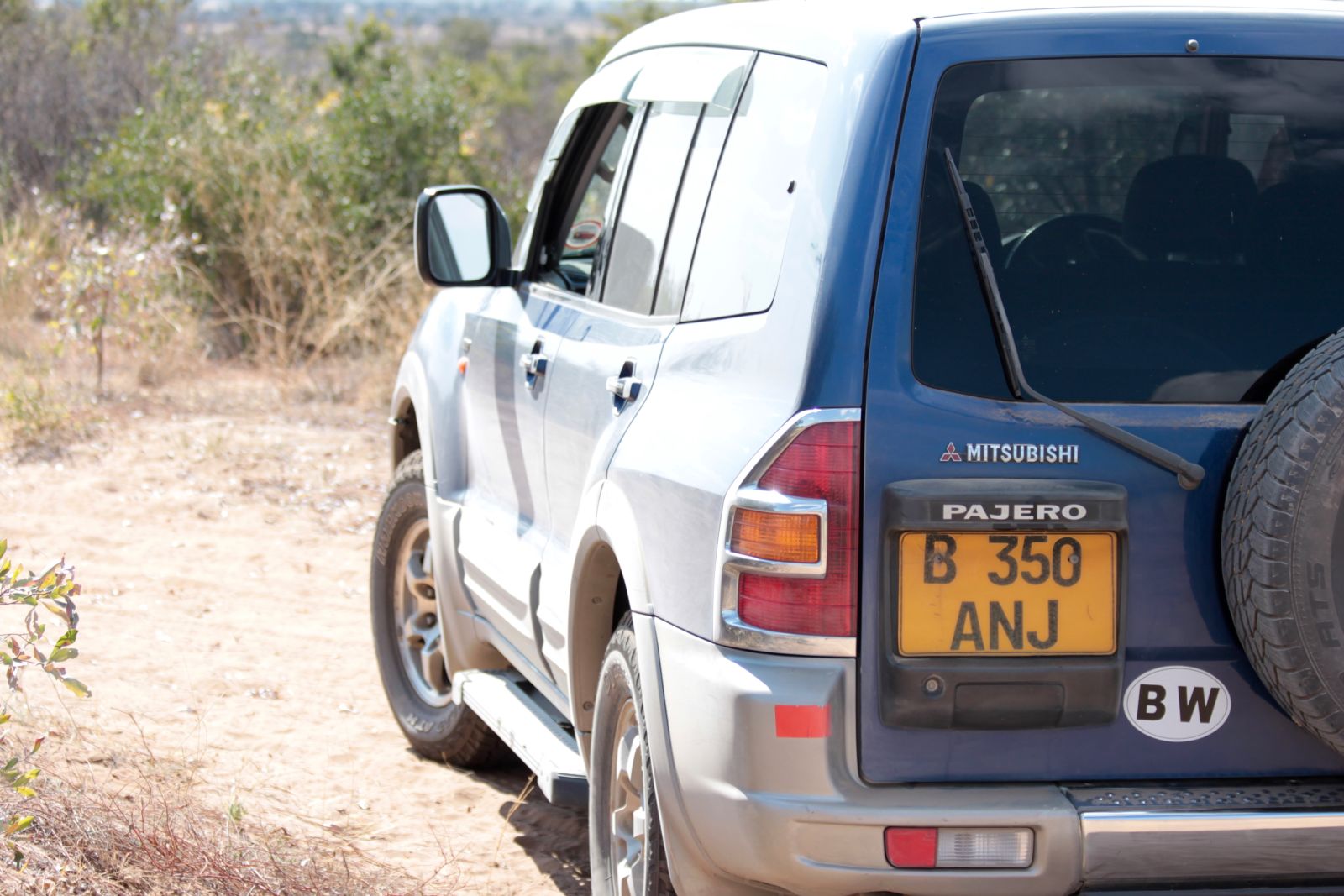
Stealth Overland. Sounds pretty cool, huh?
The Pajero got new shoes last week, and final decisions on the suspension are imminent. Now we turn toward the camping set up. While Tim and Kelsey are busy ruining the resale value setting fire to cutting the top off of their Land Cruiser, I am leaning toward an idea I’m tentatively calling “stealth overland”.
The ideas is this:
Build a safe, capable, light-weight, and reliable vehicle that we can reasonably live out of independently for up to 4 days at a time, but without going crazy with accessories, and without drawing too much attention to ourselves by festooning it with expensive equipment.
From the outside, a casual observer shouldn’t necessarily identify our Mitsubishi as an “overland” vehicle. But, when we set up camp, we can deploy an efficient living space, and we can take the hard roads to get to those camps without worrying too much about getting stranded. In short: a lean-and-mean adventure machine. Saving dough on the set up also means saving money for the trips themselves, too.
One important rule - ground tents are out of the question in this conversation (it would, admittedly, make things easier). Julie won’t hear of it, even if I could probably be convinced that it’s a good idea. We backpack in grizzly country back home regularly, with nothing but a sheet of nylon between us and oblivion. People around here camp in ground tents all the time. However...
That incident happened at Kgalagadi Transfrontier Park about two weeks after we left back in December. (Also, remind me of my supposed willingness to sleep on the ground the next time we have elephants tromping through our campsite.)
Tyres
Before I jump into those details, let’s talk rubber. I landed on the Goodyear Wrangler All-Terrain Adventure with Kevlar (USA! USA! USA!). They were currently on sale here at “Super Tires” (only $120 USD per, down from $200), and I got a little bit of a “friend-of-a-friend” discount via a referral from Hi-Range Safari City, the outfit that leant us the Cruiser back in December. They also did an alignment for me, and a general greasing and inspection of the suspension components as well.
Avi, the manager at Super Tires seemed to think all was well in the suspension department - he said our shocks were older, but seemed to be holding up, and all the bushings, ball-joints, and other assorted connections were in good shape.
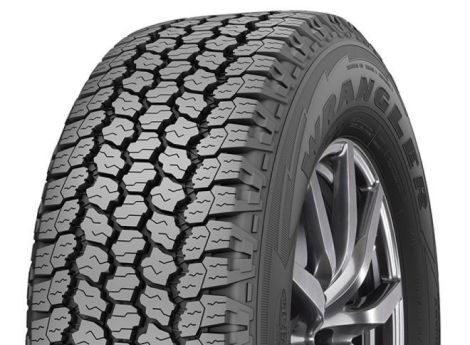
I was looking primarily for puncture resistance in the tire choice, and I think I got it. I stuck with the stock 265/70 R16 size. I bought five of them, and they seemed to do very well in sand and deep mud at the Khama Rhino Sanctuary during a short trip with my folks last weekend. My father was nearly trampled by Rhinos. Gotta keep that life insurance paid up.
General Planning Considerations
We do have size on our side - the Paj is a big boy, and if we bring a backpacker’s mentality to the problem (which we are used to), I think we can make it work.
The four questions I haven’t quite figured out are these: roof rack, fuel, shade, and refrigeration.
- Roof Rack: Our Pajero is not even equipped with factory roof rails, so installation of an aftermarket roof rack will require removing the interior headliner; and, for a decent rack like a Frontrunner, that’s probably over $1000 USD all in, not including accessories (oooof). A roof rack would free up some room inside the vehicle. However, I’m also wary about loading too much stuff up there. A roof rack also detracts from the stealth ethos.
- Fuel: The roof rack problem is related to the fuel situation as well. We have 90L in the main tank, but the Paj’s 3.5 L V6 is a thirsty beast. Given our experience during our long trip last month, I reckon I need at least 80L more to feel comfortable on some of the lonelier stretches. Carrying all that fuel inside the vehicle makes me a bit nervous, not to mention how much room four jerrys take up. However, no regulations here prohibit carrying fuel inside the vehicle, and keeping all that weight off the roof is also pretty tempting.
- Shade: It’s a necessity living along the Tropic of Capricorn. We learned that on our last trip (the Cruiser did not have an awning) - which is also related to the roof rack question. I’d love an awning, but in a pinch we are going to roll with a tarp and some poles, like Tim suggested in LionZoo’s recent rain post. We got a pair of Odoland collapsable and adjustable poles from Amazon (delivered via my parents, who are visiting this week).
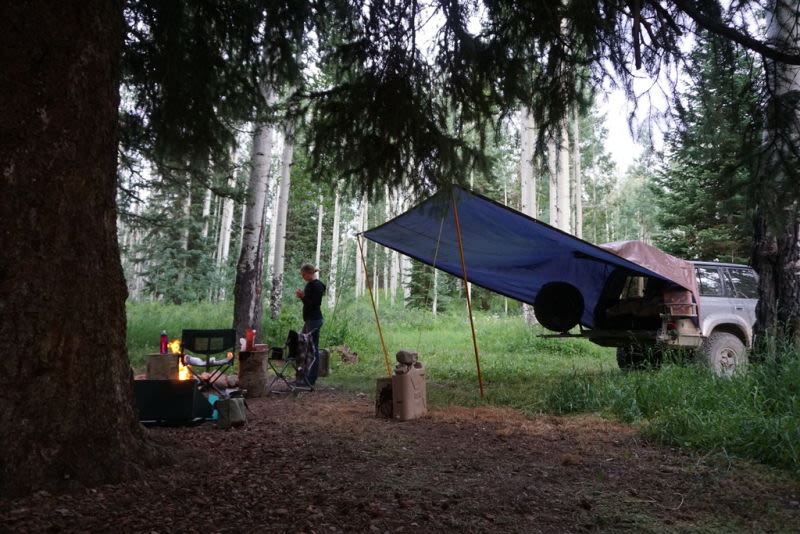
- Refrigeration: Lastly, keeping things cold. Smaller portable 12V fridges are relatively inexpensive in Botswana (Waeco brand, in particular, for some reason), and it’s the one luxury I’d love to indulge in, and that we could probably resell here. A lot of folks have them in their SUVs simply for going to the grocery store. But that might merit an expensive investment in either dual batteries or solar panels. I was also pondering just installing a good 12V cutoff switch and running the fridge from the (brand new) main battery, since we tend to be on the move every day when we travel.
Drawbacks - a small fridge is kind of pointless. And the larger ones get expensive fast. It also throws a wrench in my brilliant sleeping platform plan described below (prepare yourself). Of course, we could just go with a decent cooler, too - but sometimes ice can be hard to track down in the remoter parts of southern Africa. And, damn, I hate coolers.
Nighty Nite
Sleeping-wise, the seats are configurable to lay down in several different arrangements, and I have drawn up a rough idea for the possibility of a primitive sleeping platform that will also accommodate a basic bin-based storage solution.
The Paj has a nice high roof, and even with our air mattress in there, there’s plenty of head room. So I think I’m pretty committed to the “sleeping in the car” path, which negates the expense, the weight, and frankly, the complexity of a RTT. Getting ready for bedtime will require reshuffling some luggage and equipment every night, but reshuffling is a fact of life no matter how you camp.
The solution we deployed for our quick trip to Khutse Game Reserve last August was to take advantage of the factory “fold-flat” option:
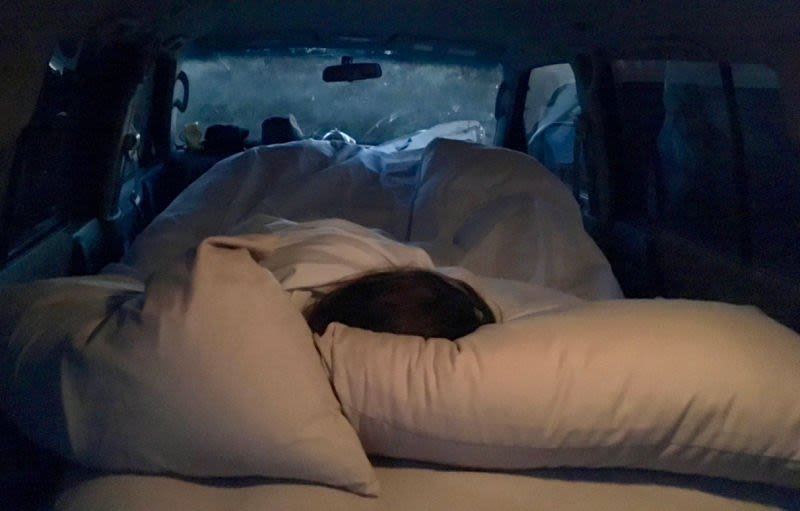
It worked fine for just a three day trip, since we didn’t have all that much stuff with us, but for a longer adventure, I don’t think it will cut the mustard.
These are the other two configurations available for the second row:
Option number one, the fold and tumble, I believe is a non-starter. At that point, I would just remove the seats altogether. Option number two, the simple fold, has the advantage of keeping the second row functional, and the foot wells available for storage. It’s still our daily, and we often drive our colleagues and friends around town when we’re not camping, so converting the thing into a pure two seater like Tim and Kelsey are doing isn’t really a possibility.
There’s a significantly large storage area under the rear floor where the 3rd row seats tumble (since removed); and, I found some decent camping boxes at the hardware store that fit nicely but not too tightly in the main luggage area, along with a tub we already owned, all of which will help us keep our crap organized. So storage capacity I think will be fine.
Here’s what I’m thinking about the platform.
Arrange my storage bins and my fuel cans like so (you’ll have to imagine three more jerry cans and the remaining bins), and build my platform to cover the rear storage area on top of all of it. The tops of the jerrys, the tallest of my storage items, happen to line up pretty closely with the height of the rear seat backs in Option 2, the simple fold mode:
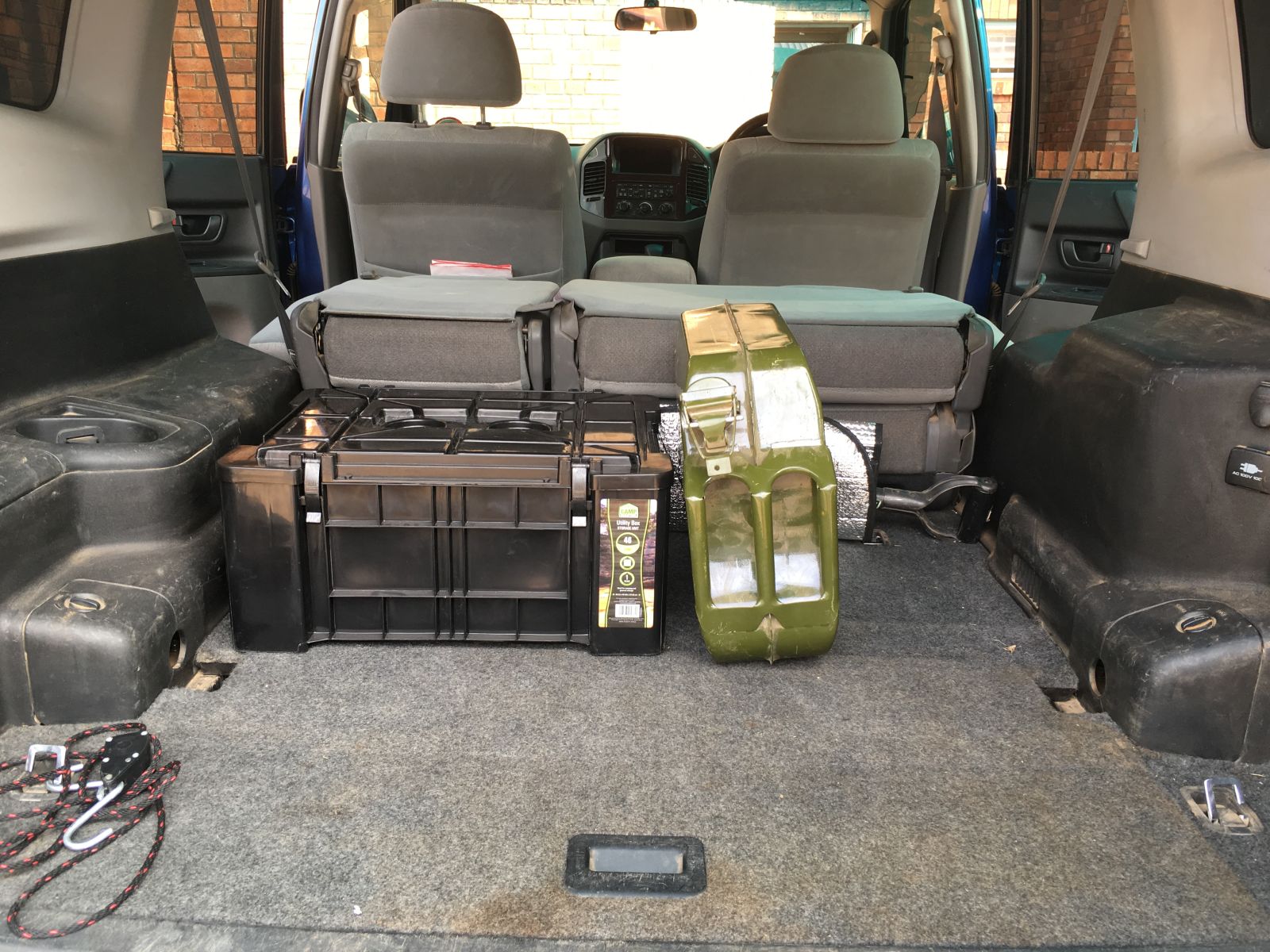
Then, build a mirror platform hinged to the original that at night can be opened forward to cover the folded rear seat backs, and extend the sleeping platform to the backs of the front seats, up to where the air mattress reaches. Also in nighttime mode, the foot wells will be available for storage of some items that normally ride on top of the platform during the day.
There’s enough wiggle room in the luggage area under the platform left over for recovery equipment and my shovel, and space between the bins for the “pillars” that would support the platform from below. There are plenty of tie-downs integrated into the floor, too, to secure the platform itself and the bins.
In daytime mode, when the “mirror” half of the platform is folded back onto itself and secured with snaps, the rear seats can be used as normal, and if needed they can tumble forward for access to the bins furthest from the rear hatch.
Additional luggage and equipment can ride on top of the platform in daytime mode, secured using tie-downs. To limit stress and keep weight down low, I would load the top of the platform with lighter items like our table, chairs, bedding, and clothes duffles, keeping our water in the rear footwells. In a pinch, the whole shooting match can be removed.
You’re just going to have to use your imagination. That’s my CAD.
There are a lot of trade carpenters around here who can help me build this on the cheap, and my initial measurements seem to bear the thing out. The one measurement I’m a little unsure of is whether the “mirror” fold-out piece that extends the sleeping surface will clear the ceiling as it swings upwards. Like I said, there’s a lot of headroom, but I need a better tape measure to triple check.
I suppose it could also slide forward, but that seems a little less stable in both daytime and nighttime configurations depending on how it’s rigged up. Though, a sliding solution could also potentially extend out of the back of the tailgate, doing double duty a work/cooking surface. Hmmm.
We’re headed back to the Central Kalahari Game Reserve on March 17 - we think we are going to tackle the long route from Khutse to Deception Valley via the lonely road that ASPW took several years ago. A bit daunting for a solo trek, and it will require additional fuel, but it would be one of those epics we won’t soon forget.